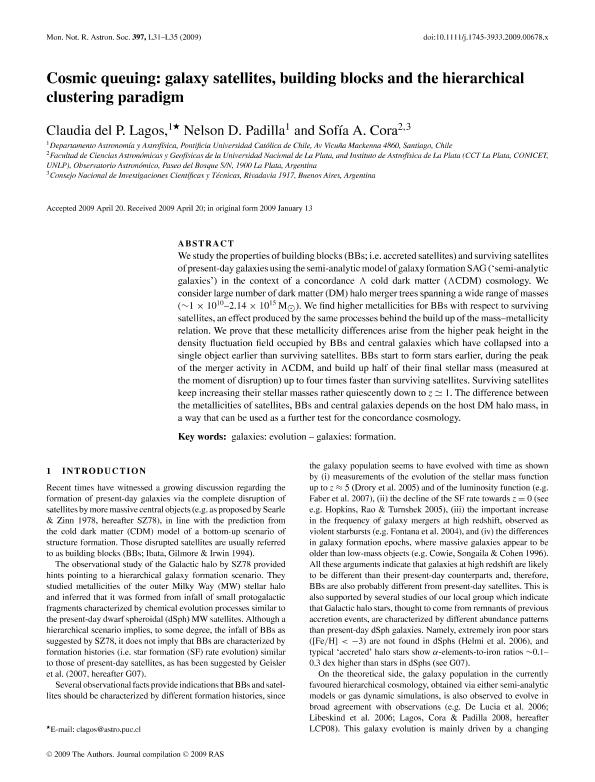Mostrar el registro sencillo del ítem
dc.contributor.author
Lagos Urbina, Claudia del Pilar

dc.contributor.author
Padilla, Nelson David

dc.contributor.author
Cora, Sofia Alejandra

dc.date.available
2018-04-20T14:16:28Z
dc.date.issued
2009-12
dc.identifier.citation
Lagos Urbina, Claudia del Pilar; Padilla, Nelson David; Cora, Sofia Alejandra; Cosmic queuing: galaxy satellites, building blocks and the hierarchical clustering paradigm; Wiley Blackwell Publishing, Inc; Monthly Notices of the Royal Astronomical Society; 397; 12-2009; 31-35
dc.identifier.issn
0035-8711
dc.identifier.uri
http://hdl.handle.net/11336/42810
dc.description.abstract
We study the properties of building blocks (BBs; i.e. accreted satellites) and surviving satellites of present-day galaxies using the semi-analytic model of galaxy formation SAG (‘semi-analytic galaxies’) in the context of a concordance cold dark matter (CDM) cosmology. We consider large number of dark matter (DM) halo merger trees spanning a wide range of masses (∼1 × 1010–2.14 × 1015 M). We find higher metallicities for BBs with respect to surviving satellites, an effect produced by the same processes behind the build up of the mass–metallicity relation. We prove that these metallicity differences arise from the higher peak height in the density fluctuation field occupied by BBs and central galaxies which have collapsed into a single object earlier than surviving satellites. BBs start to form stars earlier, during the peak of the merger activity in CDM, and build up half of their final stellar mass (measured at the moment of disruption) up to four times faster than surviving satellites. Surviving satellites keep increasing their stellar masses rather quiescently down to z 1. The difference between the metallicities of satellites, BBs and central galaxies depends on the host DM halo mass, in a way that can be used as a further test for the concordance cosmology
dc.format
application/pdf
dc.language.iso
eng
dc.publisher
Wiley Blackwell Publishing, Inc

dc.rights
info:eu-repo/semantics/openAccess
dc.rights.uri
https://creativecommons.org/licenses/by-nc-sa/2.5/ar/
dc.subject
Formation of Galaxies
dc.subject
Galaxies
dc.subject
Evolution of Galaxies
dc.subject.classification
Astronomía

dc.subject.classification
Ciencias Físicas

dc.subject.classification
CIENCIAS NATURALES Y EXACTAS

dc.title
Cosmic queuing: galaxy satellites, building blocks and the hierarchical clustering paradigm
dc.type
info:eu-repo/semantics/article
dc.type
info:ar-repo/semantics/artículo
dc.type
info:eu-repo/semantics/publishedVersion
dc.date.updated
2018-04-19T18:31:32Z
dc.journal.volume
397
dc.journal.pagination
31-35
dc.journal.pais
Reino Unido

dc.journal.ciudad
Londres
dc.description.fil
Fil: Lagos Urbina, Claudia del Pilar. Pontificia Universidad Católica de Chile; Chile
dc.description.fil
Fil: Padilla, Nelson David. Pontificia Universidad Católica de Chile; Chile
dc.description.fil
Fil: Cora, Sofia Alejandra. Consejo Nacional de Investigaciones Científicas y Técnicas. Centro Científico Tecnológico Conicet - La Plata. Instituto de Astrofísica La Plata. Universidad Nacional de La Plata. Facultad de Ciencias Astronómicas y Geofísicas. Instituto de Astrofísica La Plata; Argentina
dc.journal.title
Monthly Notices of the Royal Astronomical Society

dc.relation.alternativeid
info:eu-repo/semantics/altIdentifier/doi/http://dx.doi.org/10.1111/j.1745-3933.2009.00678.x
dc.relation.alternativeid
info:eu-repo/semantics/altIdentifier/url/https://academic.oup.com/mnrasl/article/397/1/L31/1063559
Archivos asociados
